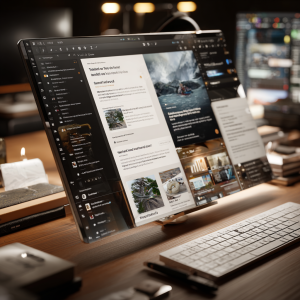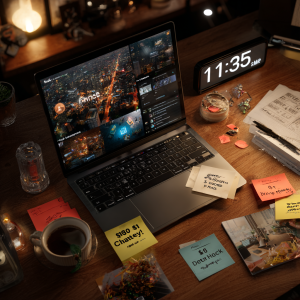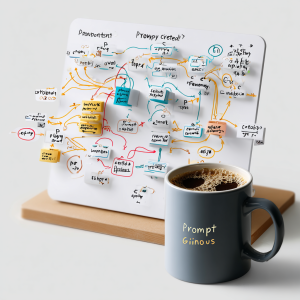
-
Tool: Tome AI
-
Focus: AI pitch decks & presentations
-
Monetization: Pitch services for startups, freelancers
-
Level: Beginner
-
XP: 100 XP
-
Badge: “Pitch Prodigy”
-
Challenge Theme: Learn, Apply, Monetize
-
Track: 30 Days AI Mastery Challenge
🎓 Professor Magnus Albright (AI Professor Voice)
“Welcome, learners. Today, you’ve unlocked the art of storytelling through Tome AI. In business and life, ideas matter, but ideas poorly expressed are forgotten. What you’ve gained here is not just a tool, but a discipline. You’ve learned how prompts shape narratives, how structure drives persuasion, and how visuals create impact. Remember, a pitch deck is not decoration; it is the architecture of trust. Whether you serve a client, an investor, or a classroom, let Tome AI help you transform raw thought into clarity and conviction. This lesson arms you with skill and credibility. Carry it forward, and let every slide you build become a story worth remembering.”
🧑🏽 Kwame Dede (Life Coach Voice)
“My friend, today you’ve done more than master a tool — you’ve proven to yourself that progress comes from action. Tome AI showed you that speed and clarity can live side by side. But the real power is not in the slides; it’s in the confidence you bring when you share them. Ask yourself: Who do I want to influence? What problem do I want to solve? That is where your journey begins. Each deck you create can open doors to clients, partnerships, or opportunities. Don’t wait for perfect. Start small, refine as you go, and watch your confidence grow. You are not just a learner anymore. You are a communicator, ready for the world.”
Key Mastery Skills
- Efficient navigation of Tome AI interface
- Prompt-to-slide generation mastery
- Editing and refining AI-generated slides
- Embedding media (videos, charts, social posts)
- Custom branding with colors, fonts, logos
- Structuring clear narrative flow (Problem → Solution → CTA)
- Collaboration and live presentation features
- Portfolio creation with before/after slide comparisons
- Applying role-based prompt strategies
- Practicing tone adjustments for different audiences
Key Concepts Covered
- Storytelling as the foundation of modern presentations
- Tome AI vs. traditional tools (PowerPoint, Google Slides)
- Narrative-first approach to pitch decks
- Prompt engineering and chaining for precision
- Cross-industry applications: startups, freelancers, educators, agencies
- Monetization models: pitch packages, freelancer portfolios, templates
- Service blueprint: defining niche, creating proof, posting offers
- Speed + polish = credibility in freelancing
- Reusable prompts as business assets
- Positioning yourself as an AI-powered pitch consultant
INTRODUCTION & OBJECTIVE
Why It Matters for Beginners
In today’s fast-moving digital world, presentations are no longer just slides filled with bullet points. They are the language of influence, the way startups raise money, freelancers win contracts, and businesses inspire trust. If you can communicate your idea clearly, persuasively, and visually, you stand out. If you can’t, even the best idea risks being ignored.
For beginners, this can feel intimidating. Traditional tools like PowerPoint or Google Slides often seem overwhelming, requiring hours of formatting, design, and alignment. Many people simply don’t know where to begin, or they end up creating slides that look generic and uninspiring.
This is where Tome AI comes in. Tome isn’t just another slide-making app; it’s your secret pitch partner. With AI-powered storytelling and design, Tome allows you to create visually stunning, story-driven presentations in minutes. Instead of wasting time on layouts, colors, or graphics, you focus on your message and Tome turns it into a professional deck automatically.
Whether you’re a startup founder pitching investors, a freelancer creating proposals, a student preparing a project, or a job seeker designing a personal portfolio Tome makes presentation design accessible and effective. It empowers beginners to think like storytellers, not just slide-makers.
If you’ve ever struggled with making a pitch deck, proposal, or product overview that looks professional, Tome AI will feel like a superpower in your hands.
Today’s Learning Goals
- Understand the core features of Tome AI and why it stands apart from tools like PowerPoint and Google Slides.
- Build your first AI-generated presentation using simple inputs, commands, or pre-designed templates within Tome.
- Learn how to position yourself as an AI pitch deck creator a skill that can be applied to your own projects or offered as a service to paying clients.
- Practice writing effective prompts for slides and structuring a clear flow of ideas using Tome’s AI-driven storytelling.
- Discover three monetization strategies with Tome AI from creating investor decks, to building personal portfolios, to offering branded decks for startups and freelancers.
Why You’re Learning This Today
Presentation design is no longer just “nice to have.” It’s a monetizable skill in the global economy. Whether you’re in tech, e-commerce, coaching, education, or freelancing, clients and investors expect clean, fast, persuasive decks that feel like they came out of a creative agency.
But here’s the shift: in the AI era, speed and clarity matter more than ever. Employers, brands, and investors don’t have time for bloated slides. They want concise, visually compelling narratives. Tome helps you deliver this even if you’ve never designed before.
By mastering Tome AI now, you put yourself ahead of the curve. You’ll be able to:
- Build pitch decks that look like they cost thousands of dollars.
- Help startups raise money with story-driven slides.
- Create polished proposals for clients as a freelancer.
- Develop personal branding portfolios that impress recruiters and employers.
Tome gives you the power of a $2,000 agency-designed deck but without the cost, time, or design stress. You bring your words and ideas, and the AI supplies the visuals, structure, and flow.
Fast Fact
Did you know?
As of 2024, more than 60% of startup decks sent to early-stage investors are now created using AI-powered platforms. The number one complaint from venture capitalists isn’t lack of design it’s “too much text, not enough story.” Tome AI solves this problem by focusing on narrative, flow, and simplicity, ensuring your audience remembers the message, not just the slides.
Key Takeaway
Tome AI isn’t just about making slides prettier. It’s about transforming your ability to tell stories that persuade, inspire, and convert. Today, you’re learning a skill that’s valuable for your own growth and instantly marketable as a service to others.
TOOL OVERVIEW: INTERFACE + FEATURES
Key Capabilities of Tome AI
Tome AI is more than a presentation tool it’s a storytelling engine powered by artificial intelligence. While traditional tools like PowerPoint and Google Slides require you to manually design every element, Tome flips the process. Instead of dragging shapes, aligning boxes, or spending hours formatting text, you describe what you need, and Tome generates a polished presentation for you.
This makes it a game-changer for beginners, freelancers, and startup founders who may not have design expertise but still need to pitch like professionals. Here are the standout features:
1. AI-Powered Slide Generation
- Type a command like: “Create a pitch deck for a new fitness app targeting Gen Z.”
- Tome instantly generates a deck with slide titles, descriptions, and visuals.
- No need to brainstorm structure — Tome creates a ready-made storyline to refine.
- Use cases: startup pitch decks, client proposals, product showcases, portfolios, and class projects.
2. Smart Layouts
- AI-powered layouts that balance text, visuals, and spacing automatically.
- No more dragging boxes or fixing margins manually.
- Example: Charts and descriptions are auto-arranged side-by-side with proper alignment.
- Ensures slides look polished and professional, even for complete beginners.
3. Embedded Media Integration
- Add interactive embeds directly into slides:
- YouTube/Vimeo videos → Product demos.
- Tweets/Posts → Social proof or testimonials.
- Figma/Canva → Prototypes and design assets.
- Charts/Dashboards → Live metrics and data.
- Keeps content dynamic and clickable — no static screenshots needed.
4. Live Collaboration + Sharing
- Web-native platform — no bulky files or version conflicts.
- Share decks via a simple link for real-time viewing or editing.
- Clients, teammates, or students can collaborate instantly.
- No broken formatting when shared — decks stay crisp online.
5. Web-Native and Responsive
- Tome decks look great across devices — laptop, tablet, or phone.
- Slides auto-adjust without breaking layouts.
- Perfect for busy investors or clients viewing on mobile.
- Ensures presentations are professional anywhere, anytime.
Setup Guide for Beginners
Step 1: Create a Tome Account
- Go to tome.app.
- Sign up with your Google account or email.
- Complete the short onboarding to test your first prompt.
Step 2: Start a New Project
- Click “+ New” from your dashboard.
- Choose “Start from Scratch” or use “Prompt Generation.”
Step 3: Enter Your Prompt
- Be specific. Example: “Create a 7-slide deck for a subscription-based eco-friendly water bottle startup. Include problem, solution, market size, business model, and CTA.”
- Tome produces a full structured deck with placeholder visuals.
Step 4: Edit and Enhance
- Edit text, swap visuals, or adjust branding colors.
- Insert new slides with AI prompts (e.g., “Add testimonials slide”).
- Use AI rewrite to polish bullet points into persuasive copy.
Step 5: Share or Present Live
- Copy a live link for clients, peers, or investors.
- Present directly from your browser with smooth transitions.
- Embed decks into Notion, websites, or email pitches.
Optional Tools to Enhance Tome
- Pexels/Unsplash → Free, high-quality images.
- Canva/Figma → Custom icons and branded visuals.
- ChatGPT → Generate persuasive text and narrative ideas.
- GrammarlyGO → Refine tone and ensure professionalism.
Bottom Line
Tome AI isn’t just a presentation app. It’s an AI-powered storytelling engine that saves hours of design work, simplifies slide creation, and produces professional decks that impress. For beginners, it’s the fastest way to create investor-ready, client-ready, or classroom-ready presentations that look like they came from a creative agency.
USE-CASES FOR DAILY LIFE
Freelancers
Use Case: Pitching Services & Winning Clients
Freelancers often need to pitch their services quickly but don’t always have design expertise or time to build a professional-looking deck. Tome AI levels the playing field. Instead of spending hours formatting slides in PowerPoint, freelancers can focus on the story the AI takes care of structure and design.
- Generates ready-to-use pitch decks from a simple description of your service.
- Adds visuals, icons, and layouts that feel agency-grade.
- Lets you embed proof (screenshots, testimonials, stats) directly into the slides.
Example: A freelance LinkedIn ghostwriter creates a deck titled “Why Personal Branding Matters.” Tome structures the flow into: Problem → Solution → Results → Services → CTA. This transforms a plain-text pitch into a visual story that sells.
Students and Learners
Use Case: Class Presentations & Group Projects
Students are often graded not just on research but on how they present it. Tome AI helps even non-designers produce professional, engaging decks with ease.
- Summarizes long text or research into structured slides.
- Adds relevant visuals to make content engaging.
- Supports multimedia like TikTok clips, YouTube videos, or charts.
Example: A business student summarizes a case study. Tome generates a flow: Background → Market Analysis → Findings → Recommendations → Conclusion, with a TikTok ad embedded for impact.
Startup Founders
Use Case: Investor or Partner Pitches
Founders spend weeks perfecting pitch decks because design matters as much as the idea. Tome cuts this process down to minutes without compromising quality.
- Generates investor-ready flows: Problem → Solution → Market Size → Business Model → Traction → Team → Ask.
- Suggests visuals, charts, and storytelling elements automatically.
- Creates shareable, responsive decks that look good on any device.
Example: A health-tech founder asks Tome for an “8-slide investor deck.” Tome builds a polished flow with placeholder data, which the founder customizes and presents the same day.
Educators & Course Creators
Use Case: Online Lessons & Training Modules
Educators and coaches often struggle with slide consistency, spending too much time designing instead of teaching. Tome turns text-based lesson notes into visual, engaging content.
- Transforms notes into slide-by-slide storyboards.
- Suggests layouts that maintain engagement.
- Supports embedding of video lessons or interactive exercises.
Example: A productivity coach creates a “5-Day Morning Routine Challenge” deck. Tome auto-organizes it into: Intro → Day 1 → Day 2 → Day 3 → Day 4 → Day 5, each branded and ready for learners.
Product Designers & Creatives
Use Case: Showcasing Portfolios & Creative Work
Designers, photographers, and creatives need portfolios that stand out. Tome AI helps present work as interactive case studies rather than static slides.
- Embeds Figma prototypes or Canva mockups directly into decks.
- Creates flows for design storytelling: Problem → Process → Solution → Results.
- Allows clients to interact with visuals in real time.
Example: A UX designer embeds a live Figma prototype in a Tome deck, alongside slides covering research, wireframes, and final polished UI — giving clients a complete story.
What Makes Tome AI Different?
- Narrative-First Approach: Tome focuses on story, not just visuals.
- Fast Iteration: Regenerate or restructure slides with one click.
- Live Updates: Real-time syncing across devices and collaborators.
- Web-Native Sharing: Share via link — no bulky files.
Bottom Line
Tome AI isn’t just about prettier slides — it’s about storytelling that persuades and inspires.
- Freelancers win clients with strong service decks.
- Students present professional-grade projects.
- Founders pitch investors without design stress.
- Educators create consistent, polished lessons.
- Designers showcase portfolios interactively.
With Tome, you’re not just creating slides, you’re creating narratives that sell, persuade, and inspire.
REAL-WORLD SCENARIO: FREELANCER MONDAY
Expanded Prompt for Tome AI
Tome isn’t just about “making slides.” It’s about helping freelancers communicate value quickly which is the difference between being overlooked and being hired. Let’s walk through a realistic example step by step.
Scenario Setup
It’s Monday morning. You’re a virtual assistant (VA) who offers inbox management, scheduling, and research support. A remote CEO from a fast-growing startup has invited you to pitch your services. The catch? You only have 25 minutes before the call. You could panic, or you could let Tome AI handle the heavy lifting.
The Prompt You Enter Into Tome
You open Tome, click “+ New”, and type:
“Create a clean, professional 6-slide pitch deck titled ‘Why CEOs Need a Virtual Assistant.’
Include the following slide structure:
1. The Problem CEOs Face (too many tasks, not enough focus)
2. Time Spent vs Value Gained (illustrating lost productivity)
3. What a VA Does (core responsibilities)
4. My Service Features (what I provide)
5. Testimonials (examples of happy clients)
6. Call-to-Action with Pricing and Contact Info”
Expected Output From Tome
- Auto-generated headings for each slide.
- Suggested icons & visuals (calendar, inbox, checklist).
- Balanced layouts with concise text and strong visuals.
- Corporate-style colors and professional typography.
- Built-in animations and transitions.
- A web link to instantly share with the CEO.
At this point, you already have a client-ready pitch deck in under 5 minutes.
Your Flexibility With Tome
- On Slide 3, you rewrite the content to sound casual and approachable.
- On Slide 4, you swap the color scheme to match your personal brand (purple + teal).
- On Slide 6, you embed a clickable Calendly booking link.
In less than 10 minutes, your deck is professional, personalized, and persuasive.
The Client Reaction
The CEO opens your Tome link during the call and says: “Wow this looks clean and clear. How did you put this together so fast?”
What they see isn’t just slides, it’s proof that you’re organized, resourceful, and efficient. You’ve built more than slides… you’ve built trust in 25 minutes.
Bonus Variations (For Other Freelancers)
- Copywriters: Pitch deck on “Why Brand Voice Matters in 2025.”
- Video Editors: Pitch deck on “The Power of Short-Form Video Content.”
- Web Designers: Pitch deck on “How Great Design Boosts Conversions.”
Each version can be generated in under 15 minutes and fine-tuned for the client you’re targeting.
Key Takeaway
- Instead of scrambling in Canva or PowerPoint, you let AI build the framework.
- You refine tone, visuals, and branding in minutes.
- You deliver decks that look agency-made — but created in under half an hour.
That speed + polish = instant freelancer credibility.
DIY TASK: BUILD YOUR TOME AI DECK
Your Mission Today: Design & Share Your Own Pitch in 30 Minutes
You’ve learned what Tome can do. Now it’s time to use it yourself. Your mission is simple but powerful: design a 6-slide pitch deck around your own skills, services, or business idea and share it with at least one real person.
The goal isn’t perfection. The goal is practice, speed, and confidence. You’ll discover just how fast Tome AI can take your raw ideas and turn them into a presentation that looks like it came from a professional design studio.
TASK GOAL
- Create your first AI-powered pitch deck in under 30 minutes.
- Experience Tome’s prompt-to-slide workflow first-hand.
- Walk away with a shareable link to a presentation that represents you, your skills, or your business.
- Build confidence in turning AI into a practical business tool.
STEP-BY-STEP INSTRUCTIONS
- Open Tome AI
- Sign in or create a free account at tome.app.
- Complete the onboarding if it’s your first time — it takes less than 1 minute.
- Start a New Deck
- Click Create in your dashboard.
- Select either blank canvas (for full creative control) or AI prompt generation (to let Tome build a framework for you).
- Craft Your Prompt
Example you can copy and adjust:
“Make a 6-slide pitch deck titled ‘Why Clients Hire Me as a Freelance Graphic Designer.’
Include slides for: Pain Points, What I Solve, Portfolio Snapshot, My Approach, Testimonials, Call-to-Action.”Pro Tip: Swap “Freelance Graphic Designer” with your actual skill, product, or idea (Virtual Assistant, Content Creator, Copywriter, AI Tutor, etc.).
- Refine Your Slides
- Use Tome’s AI rewrite feature to polish text.
- Add or edit media: drag in a screenshot of your portfolio, embed a YouTube video, or insert icons.
- Remove clutter. Keep each slide simple — one main idea per slide.
- Customize Your Branding
- Apply your brand colors (e.g., a signature purple 💜).
- Adjust fonts to match your style (minimal, playful, corporate).
- Upload your logo or personal image to make it uniquely yours.
- Optional Voiceover / Intro
- Tome allows you to add a short voiceover or text-to-speech intro.
- Record a simple 15-second “Hi, I’m [Name] and this is what I do” statement to personalize Slide 1.
- Publish + Share
- Hit Share and copy the presentation link.
- Send it to a peer, friend, or client. Or post it on LinkedIn with a caption like:
“First AI-powered pitch deck made with Tome AI — took me under 30 minutes! Feedback welcome.”
REMEMBER
- Tome auto-adjusts layouts so you don’t waste time fiddling with boxes and spacing.
- You can regenerate or reword slides instantly if something feels off.
- Don’t chase perfection. The point is to get it live quickly and gather reactions.
YOUR OBJECTIVE TODAY
Deliver your first ready-to-share pitch deck using AI without any PowerPoint stress, Canva overwhelm, or design paralysis. If you finish this, you’ll not only have a new skill but also a real-world asset you can use to win opportunities.
BONUS CHALLENGE
- Create a second version in a different tone:
- Fun & Playful → brighter colors, emojis, casual voice.
- Corporate & Executive → muted palette, serious tone, formal structure.
- Minimalistic → lots of white space, short text, clean visuals.
- Use Tome’s rewrite feature to flip tone and see how it adapts.
This teaches you how to adjust your communication style for different audiences — a must-have skill for freelancers and entrepreneurs.
Key Takeaway
This isn’t about making “pretty slides.” It’s about building confidence in storytelling with AI.
- Create pitch decks for yourself.
- Build professional decks for clients (and charge for them).
- Repurpose decks into social carousels, lead magnets, or client onboarding kits.
Today, you’re not just learning a tool you’re building a skill that turns into influence, opportunity, and income.
MONETIZATION STRATEGY
Monetize Tome AI in 3 Beginner-Friendly Ways
Why Monetize Tome AI?
Tome AI isn’t just a presentation builder, it’s a business opportunity engine. Every day, entrepreneurs, coaches, freelancers, and students need clean, persuasive decks but lack the time, design skill, or storytelling structure. By mastering prompt-to-deck workflows you can:
- Deliver agency-quality decks in hours instead of days.
- Offer affordable, clear packages that attract startups and solopreneurs.
- Differentiate as a “fast-turnaround, AI-powered deck creator.”
- Build reusable templates that compound into passive income.
Positioning angle: “What Canva did for design, Tome does for story-first presentations — and I run it for you.”
1) OFFER “STARTUP PITCH DECK PACKAGES”
Who needs it: founders pitching accelerators or angels, creators launching products, solo operators aligning partners.
Packages (examples):
- MVP Deck (6 slides) — $30
Problem, Solution, Market, Product, CTA, Contact. - Investor Deck (10–12 slides) — $60
Adds Market Size, Team, Traction/Testimonials, Roadmap, Financial snapshot. - Branded Premium — $75+
Custom colors/logos, icon set, light copy polish, optional voiceover, export assets.
Deliverables checklist: shareable Tome link, view/print PDF, cover slide thumbnail, 1 round of edits (24–48h), usage tips for the pitch.
Where to sell: Fiverr (Gig: “Investor-ready AI pitch deck in 24h”), Upwork (Tags: Pitch Decks, AI Presentations), LinkedIn DMs (search “Founder/CEO”), Indie Hackers/Twitter with before/after teasers.
Upsells: 30-min rehearsal + speaker notes (+$30–$50), KPI slide customization (+$15), data visualization polish (+$20).
Scope guardrails: 1 revision included; additional revision cycles billed; client supplies numbers/logos; you don’t fabricate metrics.
2) FREELANCER PORTFOLIO SERVICE
Ideal clients: designers, copywriters, VAs, coaches, editors, social media managers.
What you sell: a visual credentials deck that clarifies services, showcases work, and prices offers.
- Portfolio Deck (5–6 slides) — $50
About, Services, Process, 3 work samples, Testimonials, CTA. - Freelancer Starter Kit — $100+
Portfolio deck + Canva banner + Notion one-pager (bio, links, pricing).
Upsells: IG carousels or LinkedIn graphics repurposed from slides (+$25–$50), 3 CTAs variants for A/B tests (+$10).
Proof assets to show: before/after slides, story flow map, one-paragraph brand voice summary.
3) MICRO-COURSES OR TEMPLATE PACKS
Not every buyer wants done-for-you — many prefer DIY with guidance. Turn your process into products.
- Loom Mini-Course: “Create your first AI pitch deck in 15 minutes” — $19–$29.
- Template Bundle: Startup Pitch, Freelancer Portfolio, Online Course Sales Deck — $29–$49.
- Bonus Pack: icon set, brand color palettes, prompt swipe file — add +$10–$15.
Where to sell: Gumroad, Frux (Neuvation), Etsy Digital. Bundle with a checklist PDF and a 10-minute “prompt clinic.”
Prompt Template for Monetization
Create a 10-slide pitch deck for a [type of business], highlighting: Target problem, Unique solution, Market stats, Team intro, Pricing & business model, Final call-to-action. Keep design modern, clean, and persuasive.
Swap contexts: fitness coaching brand, organic skincare startup, resume writing service, local bakery going online, SaaS productivity app.
Pro move: ask Tome for three headline variants per slide, then pick the strongest.
Speed = Your Superpower
- Promises that convert: “Clean, client-ready decks overnight.” / “Investor deck in 24h.” / “Save 10+ hours with AI precision.”
- Ops tip: Block 90-minute sprints: 30m prompt→deck, 30m edits/brand, 30m export + notes.
- SLA: standard 48h delivery; rush fee +40% for 24h.
Monetization Flow (Repeatable System)
- Choose a niche (founders, freelancers, coaches).
- Collect raw notes/logo/assets via short form.
- Run a structured Tome prompt; generate full deck.
- Refine layout, tone, visuals; add CTA + booking link.
- Deliver shareable link + PDF; include 1 revision.
- Save an anonymized version as a reusable template.
Outcome: each project gets faster; margins rise with every template you bank.
Quick Start Checklist
- Create 1 Fiverr/Upwork gig: “I will build an AI-powered pitch deck for your business.”
- Produce 3 sample decks (startup, freelancer, local business) and save before/after slides.
- Publish a 3-tier pricing table ($30 / $60 / $75+).
- Post your gig on LinkedIn/WhatsApp; offer first 3 clients a discount for testimonials.
- Prepare a 5-question intake form (goal, audience, must-include metrics, brand colors, deadline).
Key Takeaway
With Tome AI, you’re not just making slides you’re building a business model:
- Pitch decks → direct income.
- Freelancer portfolios → client-winning credibility.
- Template packs & micro-courses → scalable, passive sales.
Don’t overthink it. Pick one niche, publish one gig, and launch your first offer. Your slides are now sales tools — and sales tools pay you.
ADVANCED PROMPT STRATEGY (PART 1)
Prompt Engineering 101
When most beginners try Tome AI, they type vague prompts like “Make me a pitch deck” or “Create slides about my business.” While this generates something, the results are often generic and shallow. The secret to professional results lies in the prompt itself. Think of the prompt box as your briefing room: you are the director, Tome is your production crew. The more context you provide, the more persuasive and professional the output will be. Mastering prompt writing turns Tome from a slide-maker into a storytelling engine you can monetize.
Why Prompts Matter in Tome AI
- Clarity of Purpose → Better Flow: Clear prompts help Tome structure slides logically (Problem → Solution → CTA).
- Contextual Storytelling → Relatable Decks: Mentioning your audience ensures content feels tailored, not generic.
- Tone & Voice → Emotional Connection: Defining tone (formal, bold, playful) shapes how your audience feels.
- Special Instructions → Unique Edge: Ask Tome to add visuals, testimonials, or pricing tables for a polished touch.
- Reusability → Monetization: Strong prompt formulas can be reused across niches to scale services quickly.
Bottom line: Prompts are more than text commands they’re reusable business assets.
Prompt Structuring Formula
The 5-part formula that unlocks Tome’s full potential:
- [Goal] → What’s the deck for? (fundraising, service showcase, investor pitch)
- [Context] → Who is the target audience? (investors, students, corporate teams)
- [Tone] → How should it sound? (inspiring, confident, minimalistic)
- [Slide Flow] → The order (Problem → Solution → Results → CTA)
- [Special Instruction] → Extra details (stats, testimonials, visual style)
By combining these, you create prompts that produce structured, persuasive, and professional decks.
Prompt Example for a Fitness Coach
“Create a 7-slide pitch deck for a personal fitness coach launching a remote training program. Make it inspiring, include transformation photos, client testimonials, pricing breakdown, and a final call-to-action. Target audience is women aged 30–45. Use a bold, friendly tone and include title suggestions for each slide.”
Why it works:
- Clear Goal: Sell a remote training program.
- Audience: Women aged 30–45 → makes slides relatable.
- Tone: Bold + friendly → motivational.
- Flow: Transformation → Proof → Packages → CTA.
- Special Instruction: Photos + testimonials add credibility.
Result: A high-conversion, story-driven deck rather than a bland “About Me” slideshow.
Stack and Save
The real power comes from building a Prompt Vault:
- Create a prompt that works → Save it.
- Next project → Swap the context (fitness → skincare → freelancing).
- Now you have an entire library of sellable services.
Example:
- Fitness Coach → Remote training pitch deck.
- Skincare Brand → Organic beauty startup pitch deck.
- Resume Service → Job seeker upgrade pitch deck.
One prompt formula can unlock dozens of industry niches with minimal effort.
BONUS: Role-Based Prompt Seeds
Role-based prompts save time by anchoring slides to the perspective of the audience or creator:
- Startup Founder: “Pitch to investors, focus on TAM/SAM/SOM, ROI, and growth potential.”
- Freelancer: “Showcase services, packages, testimonials, and pricing tiers.”
- Course Creator: “Highlight student results, modules, and certification tiers.”
- NGO: “Emphasize impact stories, funding goals, success cases, and urgent CTA.”
Simply adjust the industry context, and you can generate persuasive, role-specific decks in minutes.
Result: Custom Decks, Not Templates
Anyone can generate generic slides. What sets you apart is:
- Directing Tome with clarity and purpose.
- Delivering decks that feel client-specific and story-driven.
- Packaging your best prompts into reusable, scalable services.
By using this approach, you go from “freelancer with AI” to “AI deck consultant with leverage.”
Key Takeaway
Prompt engineering in Tome AI is a money-making skill. The sharper your prompts, the better your decks, the faster your delivery, and the higher your rates. Your prompts are not just instructions, they’re the foundation of a professional freelance business.
ADVANCED PROMPT STRATEGY (PART 2)
Case Study: Build a Prompt Chain
Meet Sarah, a startup pitch consultant who specializes in helping early-stage founders transform messy ideas into polished investor decks. Her clients are brilliant innovators, but their slides often look rushed, generic, or overwhelming—causing investors to disengage. Instead of relying on endless PowerPoint edits, Sarah leverages Tome AI and a structured prompt chain to deliver agency-quality decks in under 2 hours, charging $500+ per project. Her method shows how freelancers can combine AI speed with human judgment to create real value.
Sarah’s Prompt Chain Strategy
Most people give Tome a single vague prompt like “Make me a pitch deck.” This produces surface-level content with no depth or emotional pull. Sarah uses a layered approach instead, refining her prompts step by step. This ensures Tome stays focused, avoids fluff, and produces slides that resonate with investors. Her chain follows three clear phases: foundation → deepening → visual refinement.
Prompt 1 – Foundation (First Draft)
“Create a 10-slide pitch deck for a startup creating AI-powered farm sensors. Tone: visionary, yet grounded. Audience: impact investors. Slides: Problem, Solution, Market, Traction, Team, Financials, CTA.”
Output: Tome generates a 10-slide framework covering the essentials (Problem → Solution → CTA). It’s usable but still basic.
Why it works:
- Tone is set (visionary but grounded).
- Audience defined (impact investors).
- Slide flow locked (structured narrative).
This gives Tome direction and prevents generic slide dumping.
Prompt 2 – Deepening Specific Slides
“Rewrite the problem slide to sound urgent and impactful. Include 2 real-world farmer challenges, and a visual stat or data point.”
Output:
- Pain point: “70% of smallholder farmers lose revenue due to unpredictable weather.”
- Data: “$300B lost annually from inefficient water use.”
- Emotional phrasing draws investor empathy.
Why it works: Investors invest in urgent, relatable problems. This prompt creates credibility with stats and makes the issue feel pressing.
Prompt 3 – Visual Refinement
“Add design suggestions for each slide, including image ideas and layout notes. Keep the flow consistent, modern, and clean.”
Output:
- Suggests icons (📈 for traction, 🌍 for market).
- Recommends real farmer images for authenticity.
- Layout tip: “Split screen with stat left, image right.”
Why it works: Sarah doesn’t need design skills—Tome generates design guidance she can apply instantly, raising deck quality without effort.
Optional Refinement Prompts
Sarah adds extra polish with bonus prompts, such as:
- “Give me 3 variations of the CTA slide.”
- “Make the Team slide more persuasive by highlighting accolades.”
- “Suggest one-line pitch headlines for slides 1 and 10.”
These refinements make each deck feel custom, not copy-pasted.
Sarah’s Secret
The magic is repeatability. Sarah uses the same workflow for every client:
- Swap context: “farm sensors” → “mental health app” → “fintech payment tool.”
- Run the same prompt chain.
- Deliver polished decks in hours, not days.
This scalability allows her to complete 3–4 decks weekly, positioning herself as an AI-powered pitch consultant with consistent results.
Key Lessons from Sarah’s Workflow
- Prompt chaining = depth: Each round has a single focus.
- Slide-by-slide prompts = clarity: Prevents generic fluff.
- Data + story = persuasion: Always prompt for stats and pain points.
- Speed = advantage: Tome handles the draft; Sarah adds polish.
- Repeatability = income: One system = multiple clients.
How You Can Use This
Sarah’s approach applies beyond investor decks. You can use prompt chains for:
- LinkedIn posts: Hook → Refine tone → Add CTA.
- Landing pages: Structure → Persuasive copy → CTA polish.
- Freelancer proposals: Problem → Solution → Packages → CTA.
- Course slides: Outline → Add examples → Visual suggestions.
- Resumes & bios: Organize → Add metrics → Rewrite CTA line.
The same workflow adapts to nearly any content type where clarity and persuasion matter.
Monetization Angle
Turn prompt chaining into a paid service. Example pricing:
- Basic Polish ($25): 1 rewrite (clarity + grammar).
- Standard Rewrite ($50): 2 rounds (clarity + tone adjustment).
- Premium Transformation ($100+): Full 3-step chain + visual notes + A/B CTA options.
Clients love seeing their deck evolve in stages. It builds trust, showcases your skill, and justifies premium pricing.
Key Takeaway
Prompt chaining makes Tome AI your co-pilot for professional decks. By guiding AI step by step—foundation → refinement → visuals → CTA—you create content that looks agency-built but is delivered in record time. The secret isn’t asking Tome to “do everything at once,” but directing it with precision, just like Sarah. That’s how you turn generic AI slides into a repeatable, income-generating service.
PRO TASK: MAKE YOUR FIRST AI SERVICE OFFER
Today’s Stretch Task
You’ve now seen how Tome AI can create pitch decks quickly and professionally. But knowledge without action has no value. Today’s challenge is to turn this skill into a public service offer — something you can post, promote, and potentially get paid for. By the end of this exercise, you’ll have a service definition, a sample deck portfolio, and a live offer published on a platform. This marks your first real monetization step, even if no one buys today — because you’ve officially entered the marketplace.
Step-by-Step Blueprint
1. Define Your Service
Before anyone pays you, they must understand what you’re offering. Avoid vague promises like “I’ll help with presentations.” Instead, write a clear, niche-focused title and description that makes your offer irresistible.
Example:
- Title: “AI-Enhanced Pitch Deck for Startups and Freelancers”
- Description: “Using Tome AI, I’ll craft a 10-slide investor-ready pitch deck tailored to your startup, business, or personal project. Delivered in 24–48 hours with professional design, storytelling, and visual flow.”
Pro Tip: Swap “startups and freelancers” for your exact niche, e.g. “Fitness Coaches” or “Food Startups.” Narrow focus means less competition and higher perceived expertise.
2. Create a Sample Portfolio
Clients trust proof more than promises. Since you may not have client work yet, create a fictional demo deck with Tome AI to showcase your skills.
How to Do It:
- Open Tome AI → Start a new presentation.
- Prompt: “Create a 10-slide pitch deck for GreenGrow — an AI-powered urban farming startup. Include Problem, Solution, Market, Business Model, Team, and Call-to-Action.”
- Edit 2–3 slides for clarity and flow.
- Export or screenshot 3–4 high-quality slides (Problem, Solution, CTA).
Label it “Sample Work: AI Deck Demo.” Even a demo instantly makes you look more credible than most beginners.
3. Post Your Offer
A service doesn’t exist until it’s visible. Choose one platform today and post your offer.
- Fiverr: Create a gig. Upload screenshots, price at $30–$60, and let Fiverr bring organic leads.
- LinkedIn: Write a post targeting founders/freelancers. Example: “Startup founders — need your ideas to stand out? I now offer AI-powered pitch decks made with Tome AI. DM me or comment ‘Pitch’ for details.”
- Instagram: Share a Reel showing Tome creating slides in seconds. Add your offer in the caption.
- Twitter/X: Post a before/after screenshot. Caption: “AI-powered pitch decks in under 24 hours — DM if you need one for your startup.”
Pro Tip: Share in WhatsApp/Telegram groups. Community trust often brings first clients fast.
4. Use AI to Help You Sell
Don’t overthink your marketing copy use AI to draft it for you. Prompt ideas:
- “Write a LinkedIn post offering AI-generated pitch deck services. Target: startup founders. Tone: friendly and confident.”
- “Give me 5 subject lines for a cold email pitching my AI deck service.”
- “Write a Fiverr gig description for an AI-powered pitch deck creator. Keep it under 300 words, persuasive and beginner-friendly.”
Pro Tip: Save the best-performing lines into a “Copy Vault” for future reuse.
Pro Tips for Success
- Niche Down: Specialists (pitch decks for coaches/startups) win more clients than generalists.
- Pricing Strategy: Start affordable ($30–$100). Raise rates ($150–$300) once you have testimonials.
- Highlight Speed: 24–48 hour delivery is your unique edge.
- Use Proof Phrases: Add “AI-powered,” “Investor-ready,” “Story-driven,” “Startup-focused.”
Result by End of Day
By completing this Pro Task, you’ll achieve:
- A clear service definition (title + description).
- A sample deck portfolio created with Tome AI.
- A live public offer on at least one platform.
Even without clients yet, you’ll have built your first digital product, practiced pitching, and stepped into freelancing with AI.
Key Takeaway
Today, you stop being just a learner. You officially become a service provider. The first post may not bring instant sales, but it sets everything in motion. Each attempt builds momentum, confidence, and visibility. Done is better than perfect and action beats hesitation every time.
DAILY RECAP + REFLECTION
What You Learned Today
Today’s lesson wasn’t only about discovering a new tool. It was about unlocking a new income pathway through Tome AI. You learned that presentations are no longer just “slides” they are storytelling assets that win attention, clients, and investment.
- Tome AI Interface & Features: You explored how to generate polished slides, structure content flow, and embed media — all with a few prompts, saving hours of formatting.
- Cross-Industry Use Cases: You saw pitch decks for startups (investor decks, launches), freelancers (service proposals), agencies (case studies), and educators (course overviews).
- Smart Slide Generation: Practiced storytelling structures like Problem → Solution → Proof → CTA, and learned to tweak tone and visuals for different audiences.
- Monetization Models: Discovered beginner-friendly services:
- Startup Pitch Deck Packages
- Freelancer Portfolio Decks
- Templates & Micro-Courses
- Prompt Engineering & Chaining: Learned how layering prompts (clarity → tone → design → CTA) creates stronger, client-ready decks.
- Service Blueprint: Defined a niche, created a portfolio sample, and published your first AI-powered freelance service offer.
Bottom Line: You didn’t just learn how to use Tome AI — you learned how to turn it into a monetizable skill that businesses are already paying for.
Reflection Prompts
Take 10–15 minutes to write your answers in your journal, Notion, or Google Doc. Reflection locks in growth and prepares you for tomorrow.
- Surprise Factor:
- What surprised you most about Tome AI today?
- Did it exceed expectations for speed, storytelling, or design?
- Were you shocked by how little effort it took to create a professional deck?
- Ease vs. Challenge:
- Which part felt easiest (typing prompts, editing slides, rewriting)?
- Which part felt hardest (choosing a niche, pricing, designing)?
- Write why each felt that way — it guides practice.
- Confidence Check:
- On a scale of 1–5, how confident are you now?
- 1 = not confident at all, 3 = practicing but not public yet, 5 = ready to launch today.
- Explain your number. Did the portfolio exercise boost you?
- Vision for Tomorrow:
- Imagine landing your first client with Tome AI — how does it feel?
- Which decks excite you most: investor, freelancer proposals, or portfolios?
Pro Tip
Reflection isn’t about writing pretty answers, it’s about capturing growth. Think of it as a message to your future self:
- What do you want to remember when doubts creep in?
- What mistake should you avoid repeating?
- What encouragement will help you push forward?
Write as if your future self will re-read this before posting their next big offer.
Key Takeaway
Today, you proved that with the right tool and mindset, you can build a marketable service in under a day. That’s not just learning, that’s transformation.
🧠 Mood Tracker
😃 Empowered | 🤯 Inspired | 😕 Confused | 🧊 Need Help
✅ Next Step
Continue to Day 07: Play.ht – Text-to-Speech Voiceover Creation











